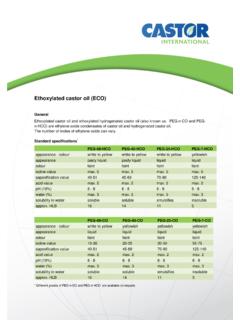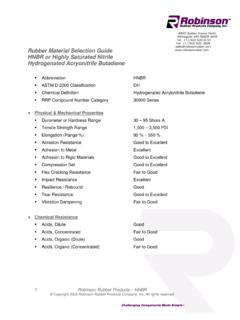Transcription of Fully Hydrogenated Oils and Fats - bakerpedia.com
1 FCC 10 Monographs / Fully Hydrogenated oils and fats /935 Octyl the following:Octyl Published: Prior to FCC 6 Fully Hydrogenated oils and FatsFirst Published: FCC 10 Octyl 2-MethylpropanoateCompletely Hydrogenated oils and FatsHydrogenated oils and FatsDESCRIPTIONF ully Hydrogenated oils and fats occur as solids at roomC12H24O2 Formula wt They are produced through the hydrogenationFEMA:2808of individual food grade oils and fats , or through theUNII: T5819 VWJ3T [octyl isobutyrate]hydrogenation of mixtures of food grade oils and fats toachieve an iodine value of NMT 4, representing theDESCRIPTION saturation of double bonds from the source oils and/or Isobutyrate occurs as a colorless to pale yellow and fats used to manufacture Fully Hydrogenated OilsOdor:Refreshing, herbaceousand fats are expressed or extracted from a range of seeds,Boiling Point: 245 nuts, fruits, and animal fatty tissues, including canola (lowSolubility in Alcohol, Appendix VI.)
2 One mL dissolves in 1erucic acid rapeseed), coconut, corn, cottonseed, lard, palm,mL of 95% kernel, peanut, safflower, soybean, sunflower, andFunction:Flavoring The fatty acid chain length distribution for these oilsand fats varies widely, however, they are typically classifiedASSAYas either lauric (coconut and palm kernel, both of which are PROCEDURE:Proceed as directed under M-1a, Appendixcharacterized as having NLT 35% of fatty acids with chain length of 12) or non-lauric (all other oils andAcceptance criteria:NLT of C12H24O2fats characterized by having NMT 2% of fatty acids with acarbon chain length of 12).
3 The resultant mixture ofSPECIFIC TESTS saturated triglycerides reflects the fatty acid chain length ACID VALUE, FLAVOR CHEMICALS (OTHER THAN ESSENTIAL distribution of the precursor oils / fats with the unsaturatedOILS), M-15, Appendix XInative fatty acids largely converted to saturated fatty acidsAcceptance criteria:NMT (these are generally fatty acids with an 18-carbon chain REFRACTIVE INDEX, Appendix II:At 20 length). Fully Hydrogenated oils and fats are insoluble inAcceptance criteria:Between and SPECIFIC GRAVITY:Determine at 25 by any reliablemethod (see General Provisions).1 This standard is intended to represent all of the listed animal fats andAcceptance criteria:Between and oils as source oils , including all varieties and fractions of these fatsand oils .
4 Marine sourced oils and high erucic acid rapeseed oils are notrepresented by the (c) 2016 The United States Pharmacopeial Convention. All rights from by corbion on Tue Jun 07 17:22:53 EDT 2016936/ Fully Hydrogenated oils and fats / MonographsFCC 10 Function:Ingredient used in the manufacture of a varietyAnalysis:Preheat the dropping point furnace to aof foods and food ingredients; or as a component for thetemperature of NLT 5 below the expected droppingproduction of a wide array of shortening products, bakingpoint of the Sample preparation. Insert the samplefats, frying fats , confectionary fats , margarines, spreads,preparation cup containing the cooled sample into cup holder, and remove from the freezer,Packaging and Storage:Store in tight containers atavoiding repeated handling of the cooled sample temperature.
5 [NOTE Bulk, molten FullyImmediately place the sample holder into the furnace, Hydrogenated oils and fats may also be stored in properlyensuring that the holder is properly seated, and initiatecovered containers at 10 15 above the melting point.]the heating of the dropping point system to completionof the analysis. (The system should be set at a heatingIDENTIFICATION rate of /min.) Record the dropping point A. DROPPING POINT temperature from the display of the dropping point[NOTE This method is based on AOCS Standardcontrol Cc 18-80 (reapproved 2009).2 The droppingAcceptance criteriapoint is defined as the temperature at which a testLauric type:30 55 sample will become fluid to flow under the conditionsNon-lauric type:50 75 of the test below.]
6 ] B. FATTY ACID COMPOSITIONA pparatus:Use the Mettler DP903 dropping point[NOTE This method is based on AOCS Official Methodssystem with accessory sample cups and sample cupCe 2-66 and Ce ]holder intended for use with this system (drip holeApparatus:Use a gas chromatograph (seediameter mm), or an equivalent dropping pointChromatography, Appendix IIA) suitable for use columns, a temperature-controlled split/Standard:Lauric acid doped with powderedsplitless injector operated in split mode, and a flame-carbon4 ionization detector (FID). The capillary column shouldStandard performance:Transfer a portion of thebe of fused silica, 100-m with a mStandard to a small beaker, and heat on a warm hotcoating of a 100% cyanopropyl-silicone stationaryplate (60 70 ) until the lauric acid melts.
7 Stir melted Standard well to ensure that the carbon is inOperating conditions:The carrier gas should be gassuspension. Transfer the melted Standard to a pre-chromatography-grade hydrogen or helium ( orconditioned sample cup, filling the cup entirely. (A pre-better purity) that has been dried, and from which theconditioned sample cup is one that has beenoxygen has been removed using suitable filters. Do notthoroughly cleaned, dried, and held in a freezer on ause nitrogen as a carrier gas for this method. The flameclean, smooth surface for NLT 10 min immediately priorgases should be gas chromatography-grade hydrogento use.)
8 Place the melted Standard in the sample cup inand air, and the make-up gas should be gasa freezer held at NMT 5 for exactly 15 min. Preheatchromatography-grade nitrogen or helium. Use a dropping point furnace to 39 . Immediately aftermm 4-mm ( ) ( ) injection port split15 min, remove the sample cup from the freezer andliner with glass wool. The injection port and theplace it into the furnace for exactly 1 min, then initiatedetector should be operated at 250 . The columnthe heating program of the dropping point system to(oven) temperature should be held at 180 . Whencompletion of the analysis. (The system should be set athydrogen carrier gas is used, the column head pressurea heating rate of /min.)
9 The dropping point of theis 170kPa (25 psi) with a constant flow rate of mL/Standard should be . [NOTE The time formin, a linear velocity of 26 cm/s, and a split ratio ofwhich the sample cup is held in the furnace prior to100:1. When helium is used as the carrier gas, theinitiation of the heating program may vary based oncolumn head pressure is 286kPa (41 psi) with athe individual instrument used. The instructionsconstant flow rate of mL/min, a linear velocity of 19included are based on the use of the Mettler DP90cm/s, and a split ratio of 100 , but adjustments will need to be made whenReagents and solutions6 using a system that has a built-in hold time.]
10 ]Internal standard mg/mL ofSample preparation:Melt a sample in a small beakertriheneicosanoin (C21:0 triacylglycerol, TAG) inon a warm hot plate and mix thoroughly. Using a pre-chloroform. Use triheneicosanoin with a purity of NLTconditioned sample cup, as described in the Standard99%.performance, transfer a sufficient amount of the meltedStandard solution:Use a suitable mixture of fatty acidsample to the sample cup to fill the cup entirely. Placemethyl esters covering the range of fatty acidsthe melted sample in the sample cup in a freezer heldexpected in the sample material. [NOTE Use USPat NMT 5 for exactly 15 Standard Mixture RS or a mixture of methylesters of pure fatty acids, in particular cis- and trans-2 Full text of the method is available from the American Oil Chemists Society(AOCS) at SP-2560 (available at ), Agilent CP-Sil883 Available from An equivalent system with a furnace and(available at ), or unit may be fatty acids, methyl esters of pure fatty acids, and mixtures of fatty acid4 Use lauric acid catalog number N-12-A available from NuCheck Prep, esters for use in the Internal standard solution and the Standard( )






